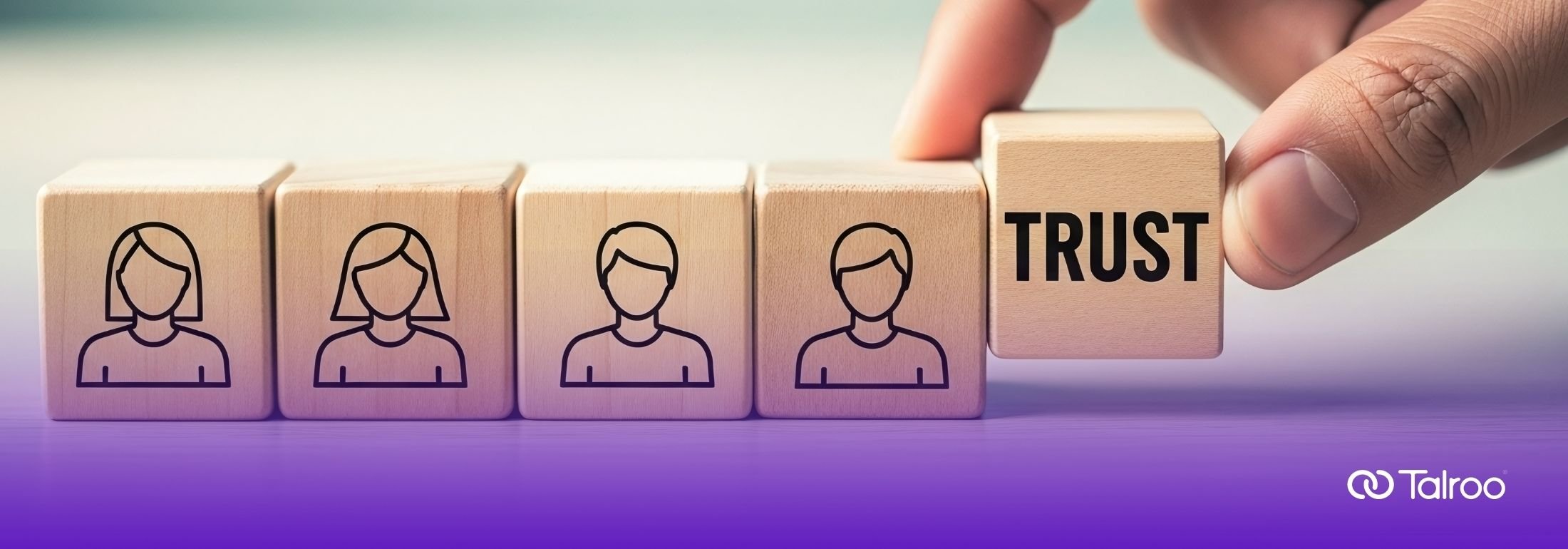
50 High-Impact Interview Questions That Reveal What Matters
Most interview questions don’t tell you much. Ask “What’s your greatest weakness?” and you’ll get the same rehearsed answers every time. But today’s hiring challenges call for sharper tools. You need questions that go beyond the surface, fresh ones that reveal how candidates think, adapt, and align with your team’s culture and goals.
That’s why we’ve rounded up 50 high-impact interview questions designed to help recruiters and HR leaders get real insight, not canned responses. Each question comes with the “why” behind it, so you can choose the inquiries that best fit your role, company, and hiring strategy.
Interview Question Bank
These 50 questions can be used for roles in almost any industry, from healthcare to retail to manufacturing. They are organized by the dimensions hiring teams care most about: Competence, problem solving & adaptability, leadership & influence, culture & values, communication & collaboration, and growth mindset / learning potential.
Each question is paired with the why: what it reveals, what you should listen for, and how to follow up. Use them to diversify your interview playbook and avoid stale questions that generate generic answers.
TIP: Don’t ask all 50 questions; pick 1–2 from each category depending on role, level, and risk areas you need to assess.
Core Competence & Role Fit (10 questions)
These probe direct domain skills, decision making in context, and ability to deliver in the role.
- “Walk me through a project you led from start to finish that’s closely related to this role — what challenges did you encounter, and how did you overcome them?”
Why: Reveals real-world experience, project ownership, problem solving, judgment. - “If hired, what would your 30-60-90 day plan look like?”
Why: Tests whether they have thought concretely about how to hit the ground running, and whether they understand priorities. - “Tell me about a time when you made a decision with incomplete information. What did you do, and what was the result?”
Why: Many roles require acting amid ambiguity; this shows risk tolerance and decision style. - “What processes, tools, or systems have you implemented or improved in past roles, and what impact did they have?”
Why: Reveals initiative, systems thinking, ability to drive efficiency or scale. - “What metrics or KPIs have you been measured against? Which of those were within your influence, and how did you move them?”
Why: Tests data orientation, accountability, ability to connect action to measurable outcomes. - “If you were handed a failure (project, client, deliverable), what would your first steps be to diagnose the problem?”
Why: Shows analytical approach, humility, and how they respond under pressure. - “Which aspect of this role do you expect to be most difficult for you? How would you overcome that?”
Why: Shows self-awareness, realistic lens, planning for gaps. - “Describe an example of when you had to learn a new tool, domain, or skill on the job. How did you approach it, and how long did it take you to become productive?”
Why: Gauges learning agility and self-led up-skilling. - “In your previous or current role, what is something you would have done differently and why?”
Why: Tests reflective thinking, continuous improvement mindset. - “Given this sample scenario (provide a mini case relevant to the job), how would you approach it? What trade-offs would you consider?”
Why: A mini exercise gives insight into their real-time reasoning and prioritization.
Problem Solving, Adaptability & Critical Thinking (8 questions)
These dig into how a candidate handles uncertainty, pivots, and creative challenges.
- “Tell me about an unexpected change or disruption in a project. How did you adapt, and what was the outcome?”
Why: Real work rarely follows plan; this shows resilience and flexibility. - “If you could redesign one process in your last company, what would it be, and how would you change it?”
Why: Tests systems thinking and pattern recognition of inefficiencies. - “Here’s a logic puzzle / brainteaser (e.g., estimate the number of gas stations in this state). Walk me through your reasoning.”
Why: Not to test “right answer,” but to observe structured thinking under pressure. - “Describe a time you made a costly mistake. What did you learn, and what changes did you make after?”
Why: Insight into accountability, learning from failure, ability to recover. - “You have limited resources (time, people, budget). Which trade-offs would you make if forced?”
Why: Helps you see prioritization, judgment, and capacity to live with constraints. - “How do you decide when to press forward vs. when to pause and reassess?”
Why: Reveals balance between execution and reflection, risk management. - “Imagine launching a new product or feature that has 50% chance to succeed, but 50% chance to hurt your brand. Would you take it? Why or why not?”
Why: Asks about risk appetite and how they frame upside vs downside. - “When multiple stakeholders disagree about direction, how do you decide whom to align with, or whether to propose a third option?”
Why: Tests diplomacy, influence, negotiation under ambiguity.
Leadership, Influence & Ownership (8 questions)
For roles with leadership or cross-functional influence, these draw out capability to motivate, align, and take responsibility.
- “Describe a time when you had to lead (or influence) a team without formal authority. What strategies did you use?”
Why: Many managers or cross-functional roles require influence beyond direct reports. - “Tell me about a time you had to give difficult feedback. How did you prepare, deliver it, and what was the reaction?”
Why: Feedback skill is a key leadership trait; also shows emotional intelligence. - “How have you handled a team conflict, especially when both sides had valid points?”
Why: Reveals coaching ability, conflict resolution style, fairness. - “What’s the biggest risk you took in a leadership capacity? What was the result?”
Why: Tests boldness, accountability, and learning. - “How do you prioritize your own time across competing management demands (people, projects, escalation, strategic)? Give an example.”
Why: Time & resource management is critical in leadership roles. - “Tell me about someone on your team or in your organization who disagreed with you, but you changed your mind. What convinced you?”
Why: Shows openness, humility, psychological safety, receptivity. - “What would you teach your direct reports about working with you? What expectations do you set?”
Why: Reveals leadership style, clarity of expectations, self-awareness. - “If you had to handle a major crisis (loss of client, system outage, PR issue), how would you orchestrate response across teams?”
Why: Simulates leadership under pressure, crisis management & decisiveness.
Culture Fit, Values & Motivations (8 questions)
These help gauge alignment with company values, motives, behavioral tendencies, ethos.
- “What energizes you most in your work, and what drains you?”
Why: Helps test fit within the role environment, avoid burnout or mismatch. - “Tell me about a time when you witnessed behavior in an organization that clashed with your values. How did you respond?”
Why: Reveals boundaries, integrity, courage to call out misalignment. - “If you could define the ideal culture for your best performance, what would it look like?”
Why: Helps you see whether their ideal culture matches yours. - “Describe an organization you admired as you looked for work. What specifically about it drew you in?”
Why: Helps you see what they value in employers (transparency, collaboration, mission, etc.). - “How do you handle failure or disappointment? Tell me about a recent example.”
Why: Culture fit often hinges on dealing with setbacks with grace or growth. - “What’s your approach when you see people cutting corners or doing subpar work?”
Why: Reveals a sense of standards, accountability, and how they handle low performance around them. - “When was the last time you helped someone grow (mentored, coached)? What outcome did you see?”
Why: Indicates empathy, investing in others, collaborative mindset. - “If you got this role, what one thing (beyond the job scope) would you try to change or improve in our organization?”
Why: Tests whether they’ve thought deeply about your company and whether they’ll try to push positive change.
Communication & Collaboration (6 questions)
These explore clarity, conflict management, cross-team interaction, and stakeholder management.
- “Tell me about a time you had to persuade someone to accept your viewpoint or idea. What was your approach and result?”
Why: Persuasion, influence, listening and adaptation in communication. - “When working on a project, what do you do when you disagree with a peer or stakeholder?”
Why: Tests conflict resolution, negotiation, tact, professionalism. - “How do you share bad news with your team / stakeholders? Give an example.”
Why: Communication under pressure, transparency, emotional intelligence. - “Have you ever been on a team where communication broke down? What did you do to try to fix it?”
Why: You want someone proactive in surfacing problems and bridging gaps. - “When delegating work, how do you choose what to delegate vs what to keep? How do you follow up?”
Why: Reveals trust, clarity of instruction, follow-through. - “How do you tailor your communication style when interacting with different audiences (e.g. engineers, marketing, executives)?”
Why: Good collaborators adjust messaging for their audience.
Growth Mindset, Learning & Future Orientation (6 questions)
These spotlight curiosity, ambition, adaptability, and long-term trajectory.
- “What’s a recent book, course, or article you read that changed how you think about your work? What did you take away?”
Why: Indicates ongoing learning and intellectual curiosity. - “Tell me about a skill or domain you want to grow. What’s your plan for doing so?”
Why: Helps you judge investment in self, realistic growth plan, ambition. - “Where do you see yourself in 3–5 years? How would this role help you get there?”
Why: A classic, but reframed: see alignment between candidate ambition and role/company path. - “If you failed to reach your goals this year, how would you diagnose why? What would you do differently?”
Why: Reveals accountability, learning orientation, humility. - “Tell me about a time you had to stretch outside your comfort zone. What did you learn?”
Why: Growth often lies outside comfort; this shows how they respond to stretch. - “Imagine the industry shifts rapidly in some unexpected direction (e.g. new regulation or tech). How would you stay relevant or pivot?”
Why: Tests foresight, adaptability, proactive learning orientation.
Final & Catch-All Reflection (4 questions)
Use toward the end to fill gaps, prompt reflection, or let the candidate surface something you missed.
- “What is one thing about your experience or background you believe we haven’t touched on, but should know?”
Why: Gives them space to showcase additional strength, narrative, or difference. - “If you had been on the hiring side, what question would you ask me (or the hiring manager) and why?”
Why: Tests curiosity, critical thinking, and whether they frame things from the interviewer’s POV. - “What would make you say no to this job, assuming we offered it?”
Why: Gives insight into deal-breakers, what the role must deliver for the candidate. - “Assume we hire you. In your first feedback review, what criticisms or areas for improvement might your manager say about you?”
Why: Reveals self-awareness, willingness to own weaknesses, and how they expect to grow.
Tips for Use and Execution
- Mix and match. Not every question fits every role. Use 1–2 from each cluster depending on priorities.
- Follow-ups matter. Always “tell me more,” “why that approach,” or “what did you learn?” are critical.
- Score with intent. For each question, define in advance what “good / acceptable / weak” answers look like, so you avoid subjective impressions.
- Mind cognitive load. Don’t fire a long string of “deep” questions back to back. Mix lighter ones (e.g. culture, motivations) with technical/probe ones.
- Customize to your company. Wherever possible, tailor a question to your industry, your values, or your specific role challenges.
- Allow the candidate time to reflect. Some deeper questions (e.g. #24, #48) benefit from a moment to think before responding.
The right interview question can change everything, helping you spot not just who can do the job, but who will thrive in it. Whether you’re hiring for speed, culture, or long-term growth, these 50 questions can help you dig deeper and make more confident hiring decisions.
Want to reach more qualified candidates before you even get to the interview stage?See how Talroo’s intelligent recruiting platform connects you with the right talent, faster.




